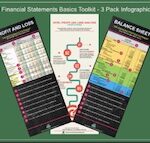Unfavorable Budget Variance in a Hotel Budgeting Process
Are you handling an unfavorable budget variance the right way?
This may be with revenue or expenses.
Handling negative variances from budgets is much trickier than it seems.
You look puzzled.
Let me explain.
It is the proverbial apples vs oranges take.
You look baffled now.
Grab this EXCEL Spreadsheet
Don’t miss our 5 Killer Hotel KPIs Dashboard
Get this exclusive Excel Template that you can customize to create your own 5 Killer Hotel KPIs Dashboard
All right, here goes.
When you compare actual results with a budget, there is a mismatch.
Actuals are evidenced by real transactions.
Budgets are estimates.
See why I used the apples vs oranges metaphor!
So, it becomes extremely tricky to analyze this mismatch.
Is there no way out?
Gosh, no, there is.
Favorable or Unfavorable budget variances are a part of the budgeting exercise.
But also yes, there is a process to be followed.
I will lay out a methodical approach to an unfavorable budget variance and related steps.
Along the way, we will answer questions like:
- What is an example of a budget variance?
- What is revenue in a budget?
- What is revenue minus budget?
- What is revenue budget vs actual?
Take a look at the infographic below on hotel budgeting and forecasting.
Click to watch the video on hotel budgeting and forecasting.
This Chapter 5 of the Ultimate Guide on Hotel Budgeting and Forecasting will cover
Handling Unfavorable Budget Variances
Let us get back to our discussion on budget variances.
More specifically unfavorable variances.
What is a unfavorable budget variance?
Simply put, it is a shortfall.
For example, look at the Paradise Hotel Profit and Loss Statement below.
I have deliberately extracted this part to explain the concept of unfavorable variances, so bear with me.
Look only at the Rooms Revenue line or row.
You have two comparisons as follows:
- Current Month Actuals Vs Budget
- Year To Date Actuals Vs Budget
The current month actual room revenue is higher than the budget.
The Year To Date Actual room revenue is lower than the budget.
In other words, the year to date room revenue is behind budget.
Or it has a unfavorable variance.
Any variance from budget can broadly be measured in two different ways:
- Variance for the month
- Variance for the period till date (also known as Year To Date)
Why is this important?
It is important because the emphasis on any performance measurement is on the current month.
The month which just got finished.
Or the month for which you will review the Profit and Loss Statement.
You may be thinking: why are we only looking at a unfavorable variance?
Why not a favorable one which is the opposite?
And you will be right.
Handling a negative or a positive budget variance basically takes the same approach.
The reason why we are tackling unfavorable variance is because it is a more critical situation.
Than when the actuals show better than the budget (a favorable variance).
However, it is important to understand a key point in the approach.
A Unfavorable (or Favorable) Variance has to be tackled separately for revenue and expenses.
Let us see how this is done.
Unfavorable Revenue Variance Vs Budget
What is the first thing to check when you find a unfavorable variance vs a budget?
You need to check whether it is for the current month or year to date.
Remember in the earlier section we learned that year to date means the period till date.
The reason for checking if it is current month or year to date is kind of obvious.
Current Month is the performance of a single month.
it is easier to relate to the performance of single month.
The next step is asking yourself: is this a revenue item or an expense item?
We will deal with revenue in this section.
The critical questions to ask about actual and budget revenue of the current month are:
- Is the variance of actual vs budget an unfavorable one or favorable?
- What contributed to the actual revenue for the month?
Revenue is contributed normally by two measures:
- Occupancy (or specifically occupied room nights) and
- average daily rate
So, when actual revenue is below budget revenue, your questions become more specific:
- Is actual occupancy lower than budget occupancy?
- Is average daily rate lower than budget average daily rate?
Do you realize what you are doing here?
You are isolating reasons for the budget variance.
In other words, you are finding out if:
- occupancy or
- average daily rate or
- both
contributed to the variance versus the budget.
This is the fundamental approach to budget variance analysis.
Since this is a budgeting basics discussion, we will keep it at this.
Just for your information, the next step is to determine for each market segment if:
- occupancy for that market segment or
- average daily rate for that market segment or
- both
contributed to the revenue variance (favorable or unfavorable) versus the budget.
You could call the occupancy part - the business volume contribution to revenue variance.
And the average daily rate part - the price contribution.
It does not matter what type or size of hotel you are considering.
These are universal steps you have to take to analyze budget variances.
Let us now see how an expense shortfall versus budget works.
UnfavorableExpense Variance Vs Budget
The approach for expenses is the same as that for revenue.
However, there is one critical step which is unique to a unfavorable expense variance.
Let us first reproduce the same steps that you take as for revenue.
You are isolating reasons for the budget variance.
In other words, you are finding out if:
- occupancy or
- average daily rate or
- both
contributed to the unfavorable variance of expenses versus the budget.
The unique factor I mentioned earlier for expenses is this:
An expense variance versus budget in terms of numbers is a positive variance.
Let me clarify what a positive variance is:
- when actual revenue is greater than budget revenue
- when actual expenses are smaller than budget expenses
Take a look at the same Paradise Hotel Room Revenue but now with direct expenses.
Notice the difference between a revenue and expense budget variance.
See the Year To Date Revenue and Expense lines and the variance column.
When revenue is smaller than budget, variance is a Red number.
Red numbers indicate negative variances or deficits.
At the same time, when expenses are greater than budget, variance is also a Red number.
You could say it this way:
- Deficit or short fall becomes a unfavorable variance with revenue
- Deficit or short fall becomes a favorable variance with expenses
- you have incurred less expenses Vs budget is a good thing!
Apart from this, expenses often are related to revenue and move accordingly.
For example:
- If actual occupancy is higher than budget occupancy,
- expenses related to occupancy (like guest room amenities etc) will also be higher than budget
It is however important to understand that these are generic occurrences.
These are not based on exceptions which could always happen.
Effect of Unfavorable Revenue Variance on Expenses
Earlier we talked about relationship between revenue and expenses.
Now, we will see a key analysis element which many hotel managers failed to recognize.
Let us bring back something we said earlier about revenue contribution:
- Occupancy (or specifically occupied room nights) and
- average daily rate
Whether a revenue deficit is caused by occupancy or average daily rate, it will impact expenses.
For example:
Say, actual room revenue is lower than budget revenue (unfavorable revenue variance).
And the entire variance is caused by occupancy.
It will mean related expenses should have gone down also.
However, say revenue went down purely due to average daily rate (price).
Then there will not be any effect on some expenses (like guest room amenities etc).
In reality, both occupancy and average daily rate combine to contribute to revenue deficits.
So, while you are measuring revenue deficits, keep the effect on expenses in mind in your analysis.
Effect of Unfavorable Revenue Variance on Profitability
There is another powerful effect of a revenue deficit versus budget.
And that is of profitability.
If a revenue deficit is caused purely by average daily rate, profitability “may” not become less.
If a revenue deficit is caused purely by occupancy, profitability will become less.
Why is this so?
This is because say, a revenue shortfall happens only because of average daily rate.
In that case, occupancy related expenses are not affected.
Remember profitability is affected differently:
- when revenue and expense change due to occupancy and
- when revenue and expense change due to average daily rate
Year To Date Factor
Remember in the beginning of this post, we saw how year to date is different from current month.
Year To Date is a difficult measure to assess versus a budget.
This is because more than one month performance is added up.
Each of the months may have had favorable or unfavorable variances as the case may be.
This is the reason why the current month budget variance analysis is critical.
Particularly when deficits happen often.
If you keep on top of your current month analysis, you should get a good handle on year to date.
So, there you are, an explanation on what are unfavorable budget variances.
Next Chapter
In Chapter 6 of Ultimate Guide on Hotel Budgeting and Forecasting, we will see how budget variances can be corrected with forecasts.
Over to you now.
How do you deal with deficits at your hotel?
Do you take specific steps to isolate revenue and expense variances?
Comment below, I will be keen to know your thoughts.
I will see you in the next chapter.
Other Chapters of Ultimate Guide on Hotel Budgeting and Forecasting
Sign Up for More Tips, Strategies and Secrets
Sign up to Speed Tips - Learn in Minutes for more tips, strategies and secrets straight to your inbox.
14







